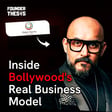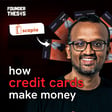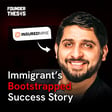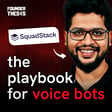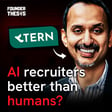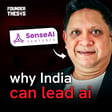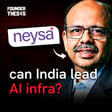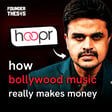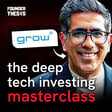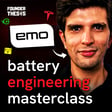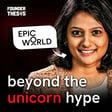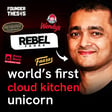Mentor's Advice on Running Towards Goals
00:00:00
Speaker
I think a mentor once told me, never run away from something, run towards something. I hold that very high in my consideration in most decisions because that is important. How did you sharpen the idea?
00:00:11
Speaker
It sounds fairly open-ended. B2B has this unique advantage where if you get it right, you can get customers to pay. and I was about to say this is an industry that faces about 30% attrition in that workforce.
Recruitment and Productivity in High-Attrition Industry
00:00:22
Speaker
Recruiting, making them successful, driving stickiness and delivering productivity and outcomes over time. One, that cycle just keeps going on. It's extremely crucial. Second, if you do well, you reduce the cost of hiring the wrong talent and losing the right talent.
Attracting Investors through TAM
00:00:37
Speaker
I'm sure you've heard of the term TAM or total addressable market. ah VCs love to look at TAMs of businesses that they are going to invest in. A business which is chasing a large opportunity, like say food delivery app, everybody orders food. So it is a large opportunity. So businesses which have large TAMs raise more money. There's fairly understood logic. But in this episode, I actually learned something which was extremely counterintuitive.
WIMO's Pivot and Business Turnaround
00:01:05
Speaker
Sometimes you need to deliberately cut down your damn group. When Yamini started WIMO, they were addressing multiple industries. They had built a Salesforce automation product, which they were selling to pharma companies and banks and a whole lot of other companies.
00:01:22
Speaker
But then they figured that it is important for them to be vertically focused. And that is what led to a complete turnaround of the business. And this episode is full of such amazing counterintuitive insights.
00:01:36
Speaker
You're listening to the Founder Thesis podcast and
00:01:47
Speaker
So Yamari, tell me your origin story, you know, like the the journey of leading up to becoming an entrepreneur, just like a broad summary.
Yamini's Journey through McKinsey and Sales Transformations
00:01:57
Speaker
So um prior to Wiimoo, I used to work at McKinsey.
00:02:02
Speaker
Most of my work there was around marketing and sales transformation for very large organizations. I had done about 15 to 20 such projects. And across the board, it felt like we were severely handicapped by tools to be able to institutionalize certain behaviors.
00:02:19
Speaker
Sales productivity typically was done, and even now in many places, is done by just monitoring activity. Whereas that is not in the spirit of recognizing a salesperson's entrepreneur entrepreneurship,
Motivations for Entrepreneurship
00:02:33
Speaker
right? So our aim was to help advise and coach them on the go and give them insights that can help them improve their outcomes.
00:02:45
Speaker
And if we did that, we felt engagement activity levels would automatically go up. So that was a different approach we wanted to take. Give me a case study, some like particularly memorable instance of frustration, which like triggered you to quit a well-paying job and...
00:03:03
Speaker
So no, I don't think it was i was, I wasn't running away with and from anything. So i was, i think a mentor once told me, never run away from something, run towards something, right? I hold that very high in my consideration in most decisions because that is important.
00:03:20
Speaker
So it wasn't, it was just, so actually when I was leaving or considering leaving McKinsey, there were two kinds of bugs ah that I was, like two kinds of itches that I was trying to
Choosing Between Public Policy and Entrepreneurship
00:03:32
Speaker
my, oh you know, all time dream of going into public policy in some way. Right. And the second one was entrepreneurship. Both were probably, ah you know, at different moments in time, different, um ah you know, different of these aspirations had higher hold on my mind.
00:03:52
Speaker
And through a bunch of conversations realized my persona and temperament was probably better suited to entrepreneurship in the shorter term. ah Until I discovered what I really cared most about from a policy point of view. Because you're going to throw your... Whenever you start that, you're going to throw a rest of your life towards it.
00:04:08
Speaker
And it has to be a cause that is really, really dear. it was too early in my ah life or maturity level to know exactly what I was passionate about solving for. How old were you at this stage when you were choosing between
Father's Influence on Career Choices (Q&A)
00:04:21
Speaker
these? by him I was probably going to turn 30.
00:04:26
Speaker
Okay. Where did that bug of public policy come in? ah So my dad used to work with Nabar. I don't know how many of the audience would know about Nabar, but it was a national bank meant for uplifting rural livelihoods.
00:04:40
Speaker
um They were the first you know lender, educator of farming practices, etc. They were strong enablers of soft stuff like Green Revolution and so on.
00:04:51
Speaker
But the role typically involved him working, traveling to a bunch of villages in the district or state that he was responsible for, driving awareness programs, driving entrepreneurship, driving lending, supporting lending, and then helping them, you know, oh deliver ROI, et cetera, right? So those led to a lot of, you know, two things. I think the whole, the fact that, hey, a farmer can have, you disproportionately different, it's very starkly different outcomes based on certain choices.
00:05:22
Speaker
The fact that a farmer is an entrepreneur somewhere, I think I started looking at all these small businesses as opportunities to really break through, right? So I got exposed to a little bit micro-entrepreneurship there.
00:05:35
Speaker
ah Because I used to tag along with him on all these village visits. But also there was a strong feeling of how much a little difference in policy can make on the grander scale, oh and right? That policy can actually make a difference to millions of people in one fell swoop versus, you know, person by person kind of transformation.
00:05:55
Speaker
So I think kind of both come from that time, the time I spent with my dad when he was doing his work. I think that was fairly progressive of your father to like take his teenage daughter along on these kind of like.
00:06:08
Speaker
Much less than teenage when I actually started. Oh wow. Amazing. He was on the
Consulting to Tech Startup Transition
00:06:13
Speaker
road all the time. So that like in the car was the way for me to get my dad time. Because those were also days when Saturday was a working day but for most public sector folks.
00:06:22
Speaker
Yeah. Amazing. So yeah. Did you have capital when you thought that, okay, entrepreneurship is what I should pursue? Like, what what was the journey from making the decision to do entrepreneurship to getting it off the ground?
00:06:36
Speaker
I think once I... had a bunch of conversations with folks in the public sector, social sector and other mentors. I felt for my temperament and, oh ah you know, level of clarity, I felt author membership might be the better decision at that point in time.
00:06:56
Speaker
And then oh there were a bunch of ideas i' was super passionate about. I won't bore you with all of those many of them are great companies now so i'm glad the ideas itself were not stupid uh right whether i was a natural owner of that or not i don't know uh uh at that point i my husband was brainstorming with me and he said what is it that you know really well that people are willing to pay money for and obviously customers were paying us a lot of money for sales transformation and i understood that quite well uh then being able to translate into a something that can be actually institutionalized as tech because I also come from computer science background. So Venkat, my co-founder and me were back at Witspilani.
00:07:34
Speaker
And subsequently, i did my MBA at IIM Bangalore and then went to McKinsey and he did his MS at Columbia University and then went to Google in the Bay Area. So he was also, he had also moved back to India at that point and was considering starting up on his own.
00:07:49
Speaker
And given I come from that background, usually tech is the first hammer to any nail that I think of. right So ah from that point of view, we were brainstorming on this and also oh it was something that we felt we had unique insight to be able to be successful.
Strategies for Early B2B Customer Acquisition
00:08:09
Speaker
He comes from the user experience background. i come from the enterprise consulting background, et cetera. and So that's how it came to be. And how did you sharpen the idea? It sounds fairly...
00:08:20
Speaker
Yeah. So you asked about capital. I think B2B has this unique advantage where ah you can, if you get it right, you can get customers to pay. um I think DNA wise, was used to consulting to very large customers. So DNA wise, I think the intent was to go up market or the subconscious. I do not even know it was called when we started.
00:08:41
Speaker
Right. But subconsciously, the, oh ah you know, idea was to go up market. And when you go up market, typically, you know, it's not, you don't need to do stuff for free.
00:08:54
Speaker
It is important to identify a problem with an early adopter who is willing to pay to solve the problem. And they understand that you're starting up and you're going co-build this with them, right? So that's what we did with our first three customers.
00:09:07
Speaker
And that's what we continue doing. In that discovery itself, we figured out, you know where where is the problem deeper? Where are people willing to put money behind this problem statement?
00:09:19
Speaker
Where is action and decision making faster? And therefore, which is a better, easier go to market for us? Who were these customers? The first three customers with whom you co-building? So initially,
00:09:33
Speaker
I did not even think much about the enterprise versus mid-market segment, et cetera. ah And the idea was who can we easily get access to? Somewhere that turned out to be mid-market.
00:09:44
Speaker
I remember the first one was a... oh agriculture inputs company. oh The second one was a... These are Indian consumer companies. india Indian. Indian. We were just testing this out. in month The intent, Bangran, I moved to India to build a company out of India.
00:10:00
Speaker
That much we knew. The problem was global. That also we knew. But to define the initial problem statement, we wanted to do it hand in hand with customers. Right. So the second one turned out to be like a consumer goods food company, packaged goods.
00:10:15
Speaker
The third was also something, I think there was one telco, one of the country's largest
Sales Transformation Challenges
00:10:19
Speaker
telcos, then one of the country's largest food companies, and then a very major farmer, and then one of the largest financial institutions.
00:10:28
Speaker
ah right And then across this, there was enough experience. We were starting build enough experience to say, mid-market versus large, where is the problem deeper? come out like their own sales motion and which one is more amenable to faster GTM motion for us, etc.
00:10:46
Speaker
What was the ah problem? So you were essentially as a consultant telling companies that here's how you can make your sales more effective. You were doing that sales transformation project. What was typically the problem and the kind of advice and that you would give? Yeah.
00:11:01
Speaker
As teams grew larger in large enterprise, productivity fell dramatically. um So there was this whole debate on a sales art or science. Only 10% of my sellers actually do, are productive or a sub for sub less than 50% in a given sales cycle, right? What percentage of sellers in large institutions are actually effective and productive?
00:11:24
Speaker
um Is it a skill issue? Is it a will issue? How do we identify this stuff? Because this is fragmented 2,000, 10,000 folks distributed across the geography, oh right? And how do we deliver coaching?
00:11:35
Speaker
um Because most of the coaching is delivered in a very top-down, on-the-job fashion, but if the... Zonal manager is not asking the right questions. If the state manager is head leader is not asking the right questions, then that cultural oh tightness is kind of lost in that whole hierarchy.
00:11:52
Speaker
Right. So how do you drive governance? So all of these were challenges and driving them through a few CRM reports was just not working because it became very reactive into do more meetings. rather than really understand that root cause on skill versus will and where behavior was
Enhancing Sales with Behavioral Data and CRM Integration
00:12:07
Speaker
broken. So our fundamental approach to this was to first map out behaviors rather than just activity and use that to learn what is it that the top performers were doing that the others were not and then translate that into so X minutes to make the first calls, so a lead is warm, time of the day, day of the week, frequency of engagement, nature of engagement,
00:12:29
Speaker
next follow-up action after a meeting, all of these, and then who to, but that is an individual activity-related planning. Then how do you spend the time in the day, and youre of your day most effective, which customers ah have a need to engage at this point in time, on what proposition, using what trigger of conversation, so on and so forth, right?
00:12:52
Speaker
So, Basically, we call this nudges. It is next best action guidance. Right. And nudging sellers on the go became our thing.
00:13:03
Speaker
Okay. What was the source of data to study? What were it like? So you were first giving up like a benchmark of. Yeah. So there was data, which was input data, like it would come from CRMs and other systems. Then there was data, which was administrative data, like hierarchy,
00:13:20
Speaker
but reporting structures and so on, which would come from other systems, HRMS or active directories, etc. Then there would be behavioral data, which we had unique capture on. we like we Since we are mobile first, we are able to get a lot of instrumentation into the app to know where engagement is.
00:13:39
Speaker
What are people seeing? What are they dismissing as recommendations? What are they acting on, etc.? So behavior data came from us, which was the unique, really unique one, which didn't exist anywhere else or ever before.
00:13:51
Speaker
And then there is outcome and motivational information, which is, hey, what are the goals and what are the outcomes and what are the incentives which we can use as a way to nudge and motivate? Yeah.
00:14:03
Speaker
I was assuming the app data would have come in later, right? Like in the early days, you probably didn't have an app. We had an app from that. That was the product. So we had it from day zero and instrumenting the app to understand engagement has always been nothing. In fact, 70% plus daily active usage, daily active usage and 60 minutes time spent by an active user on the app in 10 to 12 different sessions, five, six times in a day has always been the metric. we have Even today our NPS is 61%.
00:14:32
Speaker
right So that is a very core metric for the company and there is a lot of effort that goes into ensuring this. So you so you're saying from day one you had an app, like what did you assume the app would need to do? And obviously it would have changed with customer feedback coming in, but what was version one of the app?
00:14:54
Speaker
Version one of the app in those days was either a very lightweight activity planning system against customers or a lead management system where leads were already oh being pumped down.
00:15:06
Speaker
So it was like a mobile CRM? It was. I wouldn't call it a CRM because CRM is where usually, yes. So CRM is where you would... oh go and update what activity had to be done. This was, oh at that point, time I would call an SFA tool, Salesforce automation tool, where the entire journey would be built in and we would guide on what needs to get done in the day.
00:15:28
Speaker
And they would act on it because of which we would know that the action is done and it was logged in. That led to, because it was nudge driven, not a passive reporting tool, because it was nudge driven, because we said, here are seven things you can get done in the next two hours.
00:15:43
Speaker
And because they acted on that nudging and coaching, right? So yes, the architecture, the initial data architecture oh would reflect the CRM, right? And we pull up this data from there.
00:15:56
Speaker
ah But the entire oh translating what to act on and into a, what do you get done in a day and how do you get that done? And being able to instrument the solution to get the right behaviors in is what ah we built on top so your app had integrations with the crms that these companies were using so you could pull in the CRM so five other systems yeah so for example just saying that hey here are three leads assigned to you uh and you need to call them is very different from saying hey uh you are
00:16:30
Speaker
20% away from meeting your quarterly goal or monthly goal and out of the 20 assigned to you, here are three that have the highest probability of conversion.
00:16:40
Speaker
ah right And here is, in today's calendar, this is the best time, like 10 a.m., this is what will be most effective. after this meeting, sending these three documents as what. So translating all of those into, we used to have this design principle called one tap, right? Where with a tap, they could do this action, oh and right? And that led to a lot of engagement and action completion.
00:17:04
Speaker
I think one out of three recommendations we made were actually translated into activities done by a seller against their prospects or customers. And that was absolutely missing. ah Erstwhile CRMs had...
00:17:17
Speaker
or even today have 10 to 20% adoption in a month. Folks go at the end of the month and update everything that they need to update to meet the ah you know monitoring KPIs, but it's not used as a day-to-day guidance system.
00:17:35
Speaker
I'm just wondering, did these CRMs have that kind of data hygiene for you to make They didn't have.
00:17:45
Speaker
Most of them were incomplete and therefore the focus very quickly shifted from what was already in the system to how do you figure out what is the best use of a person's time if they have to create the opportunities themselves.
00:17:57
Speaker
And that is where a lot of orchestration playbooks got layered into the product, where if they were supposed to do a certain kind of marketing events, field marketing events to generate opportunities for themselves, if they were supposed to act on certain sets of customer basis to, you know, research them, nurture them, if they were supposed to act on online engagement triggers ah to be able to pursue certain interactions with the existing customers, so on so forth. So then a lot of these orchestration playbooks came into play.
00:18:28
Speaker
Can you zoom in a bit on what an orchestration playbook was? How did you build it? How did you how do you get the input? Because these are all different industries. What an agri-product seller has as the nudges would be very different from the pharma business nudges.
00:18:44
Speaker
So for example, i will move away from those verticals. Today we serve only financial institutions. For example, bank assurance is a very popular channel for selling insurance. The insurance player engages with bank branches and relationship managers who recommend the product to their customer when they're doing financial needs analysis.
00:19:03
Speaker
That customer is referred back by the bank to the insurance specialist, right? So this whole journey... Lead comes later. If someone is using a CRM to update which customer can now be onboarded, that's all post facto. If you've only done three, could you have done 30 is the question, right? So where did your time go and were you effective or not is the question.
00:19:24
Speaker
An orchestration playbook ah here means, hey, the number one thing is first you are assigned to three branches. How frequently are you going the to the branches? And there are, say, eight relationship managers there.
00:19:37
Speaker
How many of them understand your product, understand how to assess the customer's needs, how to include this as part of financial needs analysis that they do with their customers? How many customers are they mapped to? How many conversations do they have in a month?
00:19:50
Speaker
So being able to do this kind of discovery and relationship building with your partner in the bank. And then then seeing referrals and then having a workflow where the bank can pump a referral to you. And when the referral comes in, because the bank RM is in front of the customer, but you are not, then orchestrating a three-way conversation in in this new world of WhatsApp calls or Zoom calls or you know FaceTime calls, orchestrating a real-time three-way conversation. So the specialist on the product, the relationship to manager and the customer are in a conversation at the same time to conclude.
00:20:24
Speaker
At the end of the meeting, converting this into an automated quotation, ah right that then does many compliance checks including liveness like missile related stuff ah and then starting the onboarding process right so rather than saying hey three customers have been onboarded this month we are starting with where are you spending your time which relationship managers should you be spending your time with what stage in their awareness of your product and i ability to position it to customers are they in who do you influence
00:20:57
Speaker
Has that influence led to referrals? Have those referrals led to conversion? That entire visibility was coming for the first time. And even today, this is the only system on which that visibility
Sales Transformation and Distributor Lifecycle Management
00:21:06
Speaker
exists. This information then goes to the CRM and the onboarding tool as a customer policy application.
00:21:13
Speaker
But that's post-factor, right? This whole ah idea of where time was going and was it a skill issue or will issue? If so, where? Which part of the sales stage is something that we're bringing uniquely?
00:21:25
Speaker
Okay, fascinating. In this example, the arem the relationship managers would also be using YMOS, so you have full visibility, like how many insurance leads are generated by an RM, who's that RM mapped to as the insurance specialist for that RM.
00:21:40
Speaker
Like you can do all this cross-referencing to yeah see the effectiveness of a particular insurance specialist. yeah sope okay Okay, fascinating.
00:21:51
Speaker
ah what So again, you know this is like a further sharpening of the idea, which... ah How did that happen? Like the original idea was to... That went over the journey, ah right? You first... The bottom line is we are... Or the top line is basically we are helping you with sales transformation.
00:22:11
Speaker
Typically sales transformation problem is as I've added more people onto the team, my outcomes have got diluted. oh Right? How do I get more out of this? Right? And typically in sales, the interesting thing is you solve a problem, the choke point moves. There is no such thing as a final answer.
00:22:29
Speaker
right And that led to the product itself expanding over time to solve for newer show points at different stages, sales coaching, prospecting guidance, incentive-based marketing.
00:22:46
Speaker
motivational nudges, right? So the product kept evolving. Today we are what is called a distributor lifecycle management platform. From the time you start recruiting ah seller to onboarding them, training them, checking for compliance, getting them onto the field,
00:23:07
Speaker
oh doing the regular activities, sales activities and engagement, assessing for skill will, performance interventions, performance management, attrition risk analysis.
00:23:19
Speaker
So the end-to-end seller lifecycle is now managed on my move. There's a financial advisor who's selling. then it's worth buying WIMO because we are helping you manage that end-to-end life cycle. So I was about to say, this is an industry that faces about 30% attrition in that workforce.
00:23:34
Speaker
So recruiting, making them successful, driving stickiness, and delivering productivity and outcomes over time has, one, that cycle just keeps going on. It's extremely crucial. Second, if you do well, you reduce the cost of Hiring the wrong talent and losing the right talent.
00:23:51
Speaker
Third, even if you bring down, we help you bring down attrition severely. Even then, wherever there is attrition, there is a continuity of customer engagement related information and playbooks and best practices that are sitting in the system that help you rapidly on board and make someone successful.
00:24:09
Speaker
but Okay. You said distributor lifecycle management. This term distributor here is, does it, is it like a generic term or are you specifically talking of like say a...
00:24:25
Speaker
It's nothing to do with the CRM. It's in financial and institutions. Financial services are sold through different kind of what are called producers or distributors. This could be an agent. It could be a bank relationship manager. It could be a broker. It could be a broker.
00:24:40
Speaker
third party distributor, correspondent, oh ah right, it could be agencies which are running independently, it could be brokerages, ah right, so the language is a little it could be wealth manager, the names of who's selling is a little bit different depending on the sub vertical and financial institutions and also the geography, these are bank assurance exists in Europe and Asia, brokerage exists equilibrating in the US, right?
Focusing on BFSI for Growth
00:25:03
Speaker
So broadly, we call it distributor, but obviously our geography-wise use cases use the geography-specific language.
00:25:11
Speaker
ah These are not on payroll. These are people who are like external commission agents. So there are payroll and then there are payroll, non-payroll who are still tied to you and then there are non-payroll who are not tied to you.
00:25:24
Speaker
So there are all three structures. Okay. Okay. And... Between banking and insurance, which is the bigger vertical for you? ah Banking deal sizes are bigger, insurance number of logos is higher.
00:25:38
Speaker
Okay. Okay. Okay. Got it. ah So, you know, the this sharpening which I was talking about was also in terms of the industry. How did that happen? So you initially did not have a sharp industry focus. It was yeah from bakery to pharma, everything you were doing. How did that get sharpened?
00:25:57
Speaker
So two, three things. One is people had invested in sales tech, which their assumption CRM um would be the beginning and end of it. So they were already spending ah there. And for them to, ah but they were also, the earlier authors were also aware of the limitations and the problems.
00:26:10
Speaker
But for them to justify dollar on top of that, initially we needed a, because we walked into a very mature CRM market, right? So they needed to justify through POCs. And so that was one angle. So where do POCs happen faster? If your sales cycle is shorter, I can prove results to you faster.
00:26:25
Speaker
Which is why in tech selling, the SDR, BDR tools are fastest to sell because SDR cycles are like calls per day. Right. So the a ROI impact is much more easily visible in commoditized products like financial services than specialized products like pharma, etc.
00:26:44
Speaker
there is no direct correlation possible in most geographies between primary, secondary and tertiary sales. Right. So that was one insight. Second was ah where is a product so commoditized that the nature of the, the skillset of the seller becomes more and more important.
00:27:00
Speaker
Right. And financial advisory is one where individual products are commoditized, but you're selling a basket of products and therefore the skillsets of the financial advisor, it's commoditized, but you can't completely sell it online because you're actually,
00:27:12
Speaker
having to do financial needs analysis to build a portfolio for the customer, right? So that's where that skill set over time. In today's world, you would say, what is the first thing, like, what is the last thing Gen.ai would be able to replace, right? It was a complex sell, but the products itself were commoditized, right? So the individual who's selling and their skill sets end up mattering a lot.
00:27:36
Speaker
and i And the third was which vertical. So but this made the vertical choice for us. or Also the fact that the larger the sales team, the bigger the sales effectiveness problem. So where were large sales teams, large distributed sales teams?
00:27:49
Speaker
And the last aspect was, hey, is this a vertical that is reasonably homogenous globally? Consumer goods is not the way it is distributed. of Medical is not. a Life sciences is not.
00:28:00
Speaker
financial services was. So it was one of the largest. And if then we went and, I mean, this was after a couple of years of learning, went and studied Salesforce, went and studied Microsoft, typical large enterprise companies, because there no large enterprise companies in India as such at that point, right?
00:28:17
Speaker
So to learn about verticals, we had to go to some of the general majors. And from there, we learned 70, 80, 90% of that business was from enterprise segment, which is more than hundred kd deal sizes and 40% of that was BFSI.
00:28:33
Speaker
So that's when it became obvious that and then there were companies which were like starting to IPO e etc. we want which were heavily inspirational right like Viva etc. which had cracked the verticalization playbook and around the time Viva went for ah Around the time we were went for IPO is the time we made that verticalization choice.
00:28:56
Speaker
ah So it was good to have, we have some ah be up the same investors, Emergence Capital. So those, their, you know, recognition of the verticalization plan, backing off that also helped us push further with confidence.
00:29:12
Speaker
And then we dropped. So there were years when we, that that that year we said, that's if you're not doing any other vertical. And we work with our clients to help them find alternate solutions so we could end those contracts and focus be beyond your BFSI.
00:29:27
Speaker
Okay, fascinating. um There are a bunch of follow-up questions i want to ask you on this.
00:29:35
Speaker
So you said a couple of years after starting, you did like a slightly more deeper, ah like, digging deeper to figure out how to grow and then you realize enterprise, BFSI, global.
Cloud Adoption and Market Maturity
00:29:51
Speaker
What happened in those intervening years? Just take me through that journey. Like what kind of revenues did you start doing in the early years? What kind of ARRs were you roughly doing and what led to this realization that you need to scale and the way things are is not...
00:30:05
Speaker
Yeah, I don't think these decisions were specifically linked to, there was a time when we were already serving, thought like right after our series at series B is when we took the verticalization call, right after our series say because it was a very, like this was a 2016, 17 type of a market where there were thousands of startups coming up, getting funded, and everyone wanted a sales tool. And we served so how many of those companies that were born at that time, I think some 20, 30 of those logos.
00:30:32
Speaker
And many of them didn't exist after 12 months, right? a So trying to solve someone's business problem, them not being clear in early stage exactly what the business definition problem definition was, led to a lot of iteration on product. And then the realization was, hey, when you are starting up, you don't need to work with other startups who are also figuring it out.
00:30:51
Speaker
So that was, ah especially on a statement, on a problem statement like sales, which is not a standard operation. not like an ERP or an HRMS where people... like where the decisions are straightforward right this is a sales productivity thing and your sales productivity could be bad because your product market fit is bad nothing to do with what tool you're using right so that's that was a very high mortality rate and a lot of waste of r&d time for us so that was one theme that had happened second was this whole realization on who's willing to pay who's willing to invest in mobile first devices in those days who's more uh cloud willing to get onto cloud because we flat out
00:31:26
Speaker
said no on-prem, right? Today we are okay to go on private cloud, but that's a very different problem statement from on-prem, right? So many of these emerged over the first...
00:31:38
Speaker
three to four years as learnings. And meanwhile, deal sizes started getting bigger. So where were deal sizes getting bigger, faster? That was also a learning,
Series A Funding and Consumerization of Enterprise Solutions
00:31:48
Speaker
right? Like if BFSI has huge footprint in terms of being able to expand with different use cases, et cetera.
00:31:56
Speaker
Yeah. ah Most of these startups you were helping were all doing B2B sales? like No, not really actually. These were all kinds. ah There were some in B2B sales. There were some in like FinTech and ShortTech. There were some in weight loss programs and okay no like payment systems, so and so forth. like They were all types.
00:32:18
Speaker
Okay. Okay. Got it. ah So what was your pitch in the series a I think you raised about 5 million from Sequoia, right? Yeah. Yeah, at that point in time, we were like, hey, ah this is consumerization of the enterprise.
00:32:31
Speaker
It's never happened that tools had to be built for enterprise, keeping the end user in mind. these are The old generation is very clunky, and no salesperson wants to open web page and then update. That's absolutely not interactive. So the mobile-first consumerization of the enterprise was the story at that one time, riding the riding the cloud wave.
Navigating COVID-19 Challenges and Verticalization
00:32:53
Speaker
And I guess this like Slack would be like the poster boy of this consumerization of enterprise movement. Yeah. Okay. Fascinating. And ah the like what about geography? I think you are now focused. started in India. So at that point in time, at eight time, we were largely in India. And B is when we raised. B2 go international. And then six months later, COVID hit.
00:33:18
Speaker
But we still kept trying because we were just raised. So... We tried to do as much as we can remotely and we were able to get to the first three, four logos. We were not so great at driving success and retention of those initially because there were language issues, there was time zone issues, there was, you know, we were not able to actually...
00:33:37
Speaker
really understand, like India may have been locked down, but US was on the field and we were just not able to understand our end users and a day in the life as much as we wanted to. So like we had some of those learning and success and retention, but we did try go to market because like nobody knew when COVID would end. be Like we couldn't shut shop and wait for it, right? So we kept trying and post COVID is when we put boots on the ground based on those learnings. And then we had a new set of learnings.
00:34:02
Speaker
But we kept chipping away at it. yeah The verticalization decision was kind of also like an outcome of COVID. Just pre-COVID. That was another funny thing. we told We sent a notice to all our non-vertical clients that, hey, we are moving out and then COVID hits, right?
00:34:19
Speaker
And God, I could have used that revenue.
00:34:23
Speaker
I was like, you can never tell what, like, it was such a bold decision and we were all so, strong we had such strong conviction and then COVID hit and there was huge churn risk across the board and but like, oh my God, we went and put 20, 25% of our revenue on notice already.
00:34:41
Speaker
You know, a lot of founders struggle to say no to business, like to say no to a client who's giving you annuity income, uh,
00:34:52
Speaker
what a What is the mindset that a founder should have so that they are able to take these kind of hard calls? I think, I mean, it's not been easy for us either. And I don't know if I can be a purist and say that 100% of what we do is perfect over time.
00:35:09
Speaker
like over the time time ah I think or constraints help in taking a hard call, oh and right? Our ability to, how fast can we build to cater to the different nuances? Where are we investing time but not seeing value?
00:35:25
Speaker
Time was a constraint at that point in time, right? Founder time and we had to focus, right? ah In today's generation, for like for the last two years, capital has been a constraint for everyone in the SaaS community. And therefore, we've all had to focus. right So I think constraints are good. So always have artificial constraints. Don't ah take for granted the cash that you have raised and is in the bank.
00:35:46
Speaker
It can always be put to use on things that are momentum driven. Right. but um Right. Or fresh experiments fail fast. Right. I think if you're thinking of how to get from 1 million to 2 million, yes, it feels like, you know, you want to keep on holding to the annuity.
00:36:03
Speaker
But you think about the fact that you need to get from 1 to 10 and 10 to and 20 to 50, then you realize you need speed more than anything else.
Iteration and Learning in Startups (Q&A)
00:36:13
Speaker
Like, it's easy to say very tough to do. It was not easy for us oh psychologically to say that, you know,
00:36:19
Speaker
ah Because there is this other thing, every time you make these decisions, there is this whole, oh, you're pivoting, right? And I don't know if that's a good word, bad word, ah but it is learning, right? And and if that is, a I don't know if that is the right word to represent learning and failing fast, but I can't imagine a startup was born with an idea of a product or a service and 20 years later, that's exactly what they're doing, right? I'm sure so there is a lot of learning loops and iteration that need to happen.
00:36:46
Speaker
It could happen on product, it could happen on pricing, it could happen on people, it could happen on markets. Right. And I think calling it a pivot is a very, yeah, weird thing.
00:36:59
Speaker
What does this space look like of Salesforce automation space? Oh, massively cluttered. When we started, Traction sent us a report saying there are 770 other players. Congratulations. and I was like, so hugely cluttered. Therefore,
00:37:13
Speaker
Therefore, like, I mean, like, can you bucket these companies? Like what broadly? So there's sales enablement, there's sales coaching, there is sales. Give me examples also. Like, like I mean, for someone who doesn't understand.
00:37:25
Speaker
Sales training would be a mind tickle and size, mind tickle equivalent sales. Voice based training would be a, you know, ah chorus or gong equivalent conversational ah coaching, etc.
00:37:41
Speaker
Content-related enablement would be a seismic, ah probably again a mind tickle, ah and right. um then i Then there is communication support, ah right, which would be companies like here, say, right,
00:37:57
Speaker
which is compliant communication related stuff. There could be gamification and there are many small custom companies playing in that. There L&D, there is incentives and rewards, ah there is sales compensation management, there is lead management, right?
00:38:14
Speaker
So, and depending on the verticals like in CPG, et cetera, there is beat planning. So there is a lot. There is a lot.
00:38:25
Speaker
Yeah. And then there are CRMs itself, which are, again, many. Right. Yeah. The CRM market is ah probably the largest of these, right? The ones that you mentioned. It's a large category it's less like the bare minimum of a company needs yeah to run a sales team. Yeah. Okay.
00:38:41
Speaker
Okay. You are still working with the CRM as your base or are you also so providing a CRM? We integrate with about six to eight different systems in an organization. CRM is one of them.
00:38:54
Speaker
oh It is a critical one, but there are many that are equally critical in the case of financial financial advisory. and yeah What are the others that you integrate with? Usually the customer onboarding systems are critical.
00:39:09
Speaker
oh The systems like... uh, uh, there are many rules, validations, guidance type of systems, which actually help you underwrite, make underwriting decisions, uh, which are extremely critical.
00:39:24
Speaker
Yeah. Okay. Okay. Okay. And, uh, so we were talking of you going global. You started by first selling remotely, uh, from India because it was COVID.
00:39:34
Speaker
Uh, how did you figure out how to crack global sales? And, uh, you know, how did that, uh, What were the learnings which happened there? and The learnings have been, ah yeah. So there are many learnings, ah but definitely one was, first of all, in product market fit itself.
00:39:54
Speaker
oh It is very important the way, YMA has a certain range of product even today. In a market like Japan, they would want to consume a very small part of it first.
00:40:06
Speaker
And it's a 10, 15 year journey to consume the whole part of it. In a market like Asia, you want the whole thing and all the strings attached and five other custom solutions built on top.
00:40:17
Speaker
In a market like US, you are usually solving for a specific problem and that is the component you want and you want it reasonably standardized. right
Building a Scalable Sales Team
00:40:25
Speaker
So there is up like, you know, the range of appetite oh is very different on a product on product consumption or platform consumption.
00:40:34
Speaker
um ah So that is one aspect. the The need for, that in our case, because we were speaking with buyers who required local teams, ah both from a compliance point of view and from a language point of view, and from a time zone point of view.
00:40:51
Speaker
ah right, from an engage, because these are multi-threaded conversations, we needed to get multiple people aligned to make these large decisions across multiple functions, ah and right, and so that required local booths on ground to manage time zone, even if the meetings there were happening on Zoom, we needed time zone management, oh right, um so that was a big learning, then in terms of types of sellers itself who can be successful at Wymo,
00:41:17
Speaker
That was a very big learning. As we kept going up market, certain sellers who worked well for us did not scale. As initial sellers who, as individual contributors, did a phenomenal job, did not scale as managers.
00:41:33
Speaker
oh and right Folks who scaled in the 0 to 1, the folks who were able to get the first three logos really struggled in scaling that to you know three logos a quarter kind of a momentum.
00:41:44
Speaker
right So they were very good at Initial product market fit kind of roles, not great at scaling repeatability, right? They were constantly in experimentation mode when we should have focused on scaling what was working rather than trying new things out, right? So that was, I think that's generic learning for any company, right? oh the Angle for us also becomes that learning cycles are long because to hire onboard a seller and like even to recruit and bring the right seller says three months, about four to six months for them to ramp.
00:42:20
Speaker
Pipeline average sales cycles itself are between six to nine months on an average for us. So by the time you go through success in a few cycles and realize choke point in the next cycle, it's ah it's almost if you want to reboot anything in that geography from a go-to-market, that's a two-year process.
00:42:36
Speaker
um Right? It's a two-year process initially to show success. But if you make a mistake, then it's a two-year process to course correct it. oh Right? So then ah when the... when oh when you raise funding and the times that we raised funding, typically it was to de-risk ourselves from the store.
00:42:53
Speaker
So have multiple of these pods running, then be dependent on that one salesperson for success or fail, right? So have at least a couple of parallel pods running. This was something that Sudhir Nair of Nutanix told me that ah the reason you raise is to have, to de-risk yourself in this learning phase, right? And definitely have two pods at the least running in any new product market c situation that you're working on.
00:43:22
Speaker
right So all of all of these. And then, of course, it didn't help that COVID was going on. So is it product? Is it market? Is it seller? oh Is always a big question mark because there is enough evidence to and for, for and against most situations. So that was a big deterrent. Yeah.
00:43:41
Speaker
um Okay, fascinating. oh What does a include? A usually, I mean, a large enterprise who would include a BDR to keep the top of funnel momentum going against target accounts, a seller, and a pre-sales person.
00:43:56
Speaker
Now, it doesn't mean that one is to one ratio is needed, but at least one is needed initially, right?
00:44:02
Speaker
And ah so when you... Essentially, when you enter a new market, you want to have two sales pods or salespeople who are independent of each other, each one trying their own strategy so that you are able to figure out which strategy is working and then yeah scale that up.
00:44:20
Speaker
yeah You were talking of how each market has ah unique requirement of how they buy So essentially, these pods help you discover that market. Like, how does this market buy? During the interview stage itself with the pods, we learn a lot that, you know, because we keep hearing that in the interview, that's not how it works here, et cetera.
00:44:37
Speaker
But obviously you need to test it out because it's not always that that's exactly what happened in the market for us, right? Because your product cit situation is also unique. You're selling into a certain kind of a vertical.
00:44:48
Speaker
So there are those nuances also, oh right? So oh yes. How do you hire a salesperson, a BDR? In the case of WIMO, there are two, three angles that matter.
00:45:02
Speaker
oh The number one thing is oh that at this point in time, given how specialized we are and that, you know, yeah are these are half a million deals that we are closing, you need to have knowledge of the industry. So typically we have hired folks who come from the industry or have sold heavily into the industry.
00:45:16
Speaker
They need to know the north- north motion of large deals, right? Multi-threading, value selling, everything. and
Value Selling in Sales Processes
00:45:25
Speaker
the third aspect is value selling actually like front office is solutions where you need to show ROI on a pre-existing stack oh and rather than back office solutions or middleware etc operational solutions right so these were the three criteria that initially we compromised on one or two of these over time we have become reasonably strict at having all three in place can you zoom in a bit on value selling ah you said this is a front office uh like what is that in our case for example folks had invested in a crm right so for them for us to justify delta both on our roa and pricing on top of that uh you need to be able to build that story so you have be very needs driven uh pain point driven uh show exactly the not the
00:46:10
Speaker
hundred things that WIMO can do, but exactly the seven things that will change their life and very quickly, right? Be able to convert that into an ROI story. So talk business metrics to them, KPIs, right? And be able to help them champion this internally, right? So that requires W2R value selling.
00:46:28
Speaker
And so value selling would start by doing a lot of discoveries in a sense. Yes. Because you need to find out what are those five things which really matter this customer.
00:46:38
Speaker
And for good discovery, you need an insider who can talk their language. Like somebody from who doesn't understand banking yeah would not be able to do effective discovery. ah but I think initially we went got ah got away by doing basic like lead management problem people can very easily start talking about.
00:46:57
Speaker
But as we got deeper and deeper, as our platform became deeper and as our deal values became higher and as we started going to larger and larger logos, then there is always complication in their existing stack.
00:47:09
Speaker
right And now we are talking to CTOs to be the single platform. They don't want 10 apps. So at that point in time, there is a lot of objection handling coaching that needs to happen. And for that, industry knowledge really helps.
00:47:23
Speaker
Okay. And what do you mean by multi-threading? You said that they need to learn. like stakeholder yeah Multiple stakeholders need to sign off. decision you cannot be just single threaded with a cto or a sales leader uh eventually everyone needs to be convinced that is the right answer because it has multiple users budget comes from tech usage is by business uh bill has be paid by finance so yeah this question is somewhat coming from a personal space but does a good seller need to be an extrovert or do you think introverts also can be good sellers
00:47:56
Speaker
I don't think it makes a difference. I
Geographical Expansion and Revenue Distribution
00:47:58
Speaker
think I've seen both. Okay. Okay. Interesting. interesting ah And the couple of months of wrap up time, which it needs, that is because they also need to learn technology or do you hire people who also understand technology?
00:48:15
Speaker
ah Typically we hire people who understand technology. We have done, who have been in tech companies, in tech sales. Yeah. Tech sales to banking sector, like that's your ideal hire.
00:48:27
Speaker
Tech sales to financial sector. Yeah. To finance. Okay. Right. Right. Okay. Okay. Fascinating. ah So today, what is your like, you know, geographical split of revenue? Like which countries are like your top three countries in?
00:48:41
Speaker
India has still a major market for us. Southeast Asia very fragmented, but together some total of that is big. We see that as a unit because we play with, ah we work with multinationals who have multiple operations in these countries. right um And oh markets like US, Japan are emerging.
00:49:01
Speaker
Where we've gone through the iteration of initial wins, building up the right team, oh and now are in the growth stage. What drove this growth?
00:49:13
Speaker
Was it on the back of better PMF or ah better sales motion or? Everything. Discovering new markets, figuring out our sales motion, all of these were running in parallel.
00:49:27
Speaker
Mm-hmm. right? oh I mean, over a four-year time, there is a lot of stuff you will have to fix and figure out. So, yeah. But basically, learning how to scale in a lot of places.
00:49:39
Speaker
ah But also, while some markets are at scale, some are early stage. So, the DNA of the company, one side you're trying to stabilize, one side you're trying to experiment,
Managing Rapid Growth and Work-Life Balance
00:49:50
Speaker
and right? So, it's not been easy, I would say.
00:49:53
Speaker
But I don't think it's easy for anyone. So, yeah. How do you personally,
00:50:01
Speaker
like like, you know, this sounds like something which could easily burn out a founder, this kind of growth, like 12 to 15x growth over a four-year period, unless you are really good at managing processes, managing people, you know, leadership.
00:50:18
Speaker
so So can you share some of your, like, how do you how do you manage it? Like, what are some of those frameworks that you use?
00:50:30
Speaker
So typically, couple of design principles I have. If I'm doing something a lot this quarter, then next quarter I would like someone... oh I would like to have someone in my team learning how to do it or add to the team so there's a person doing it full time, right? So basically, if you've figured out a playbook, then it's better that it's delegated to someone who can repetitively institutionalize it rather than you doing the intervention itself, right?
00:50:58
Speaker
um So that is one thing that has helped in scaling. or Typically, the second part is I think I spend a lot more time interviewing my direct hires, right? than managing them after, ah and right? So I've spent hundreds of hours in finding the right people into these roles.
00:51:16
Speaker
Honestly, not everyone has worked in spite of that, right? But once we know this is working, it's easier for me to, you know, just back off and let them do their thing and ask for help, right? And just run on the basis of broad design principles.
00:51:33
Speaker
Okay. I think those are two that I've held. But also, I think ultimately, every founder needs to remember that this is just a job. Right? Like, I mean, I think many, maybe investors may not like to hear that. So maybe you can edit that line.
00:51:51
Speaker
But let me think of a better way to it. Founders have to remember that this is this is a job, ultimately, right? And there is also life. um And both go in parallel. Please don't put life on hold for your job.
00:52:03
Speaker
oh And hopefully you also don't need to put your job on hold for your life to happen. right You'll have to find the light right kind of leverage in both the places to be able to balance it and keep making progress.
00:52:16
Speaker
I want to zoom in a bit on how you decide this is the right hire. So you said that because you invest more in selecting the right people, so therefore the time you spend in managing them gets reduced.
00:52:28
Speaker
So what is your decision-making framework when you're hiring for a role? So what typically, oh one is obviously the basic criteria, the three things that i if it's sales and the functional criteria, right, on their experience depth and whether that's their strength or not based on where our need is, etc.
00:52:46
Speaker
But outside of all of that, culture fit is a very important thing. I think even at this stage, I know we are a company where bias to action, customer obsession, and willingness to fail fast, openness to feedback, openness to being coached, oh acknowledgement of, ah you know, and seeking of help, acknowledgement of gaps and seeking of help, openness to being governed.
00:53:12
Speaker
These things matter a lot, and right? People who focus on solution rather than, the problem, solution rather than problem. the People who focus on the problem rather than the people in the discussion. These all come out when people are talking about, hey, why did you leave this company? And that's like one standard question I have.
00:53:30
Speaker
You've moved across four companies. Tell me why did you leave each of these places? We're constantly bickering about this person did something. I did not like that person, right? You can be a citizen. You can be, you know, outsider, right? If you are, if you're chosen to be a citizen,
00:53:48
Speaker
then you have the obligation to act, right? And not walk away. Because every place has its tough times. Every place has its quirks. And everyone knows that. But being able to find solutions and get past that and build a culture that everyone likes is your responsibility as much as anyone else's, right?
Aligning Hires with Company Values
00:54:08
Speaker
So these come up in the storytelling. so oh And then...
00:54:13
Speaker
Doing some exercises with them on, hey, how would your first 90 days look like? How would you solve a certain situation? oh Right. Exercises where they're supposed to write stuff down actually shows a lot on willingness to roll up sleeves.
00:54:31
Speaker
Right. What they've written down, whether it looks like a framework or whether it looks like actual to do list. And ah you can always judge a person's understanding of the design principles by looking at their activity list.
00:54:45
Speaker
And you can always, you know, you can also. ah But are they biased? towards action, which comes from detailed planning on exactly where they want to spend their time versus, you know, just purely framework-led, which is, in many of these interviews, I've seen people say, first 30 days I'll spend to understand what is happening on the ground.
00:55:09
Speaker
What does that mean? Right, right. and Right. You could have said, hey, there are 30 customers mapped in my market.
00:55:21
Speaker
Let me assume when I ping them, it may take a week to schedule. But in 30 customers, maybe three stakeholders are important. That's 90 meetings. In my first 30 days, I want to do these 90 meetings.
00:55:35
Speaker
right That is actually thinking about how will you learn in the first 30 days? right and it So how how oriented are they towards action?
00:55:46
Speaker
Of course, in 30 days, you can be on back-to-back Zoom calls and try to observe and learn. but are you creating the activity to learn or are you listening in and trying to learn? Because unless you try to solve a problem, you will not come against a choke point.
00:55:59
Speaker
oh and right So these are some of the pieces. oh right And so usually you would want to have the luxury of time and multiple interactions. So over time, people have liked in the industry, have stayed in touch with them. And over time, we have brought our partners as our salespeople, our customers as our customer success people.
00:56:22
Speaker
ah right So that really helps because you've got to observe them for a while. And ultimately, Vaikaran, my vision of building Wymar is also, hey, this is has to be a very sharp shooting team that...
00:56:35
Speaker
oh is holding dear a set of values, most important of which are customer obsession, you know bar for excellence, seeking of excellence and integrity and respect for others and so and so forth. right and bias to action, etc. right So we have to be a family.
00:56:54
Speaker
So the most time we get to spend with each other is the better it is. But there have been times when we were under huge amount of pressure to close certain positions, many positions and We ended up hiring fast. We made a lot of mistakes oh across the organization, ah right? And there were learnings from that.
00:57:13
Speaker
It's not that these were bad people. My usual comment is, hey, Albert Einstein would have struggled at McKinsey. Einstein wouldn't have been successful at MIMO either, right? So it's just time and place and culture fit, right? It doesn't mean they're good or bad. And that's, you know, it's the important it's important to also acknowledge the fact that When someone has failed in your organization, you have also failed in being able to assess this sooner.
00:57:44
Speaker
right so So that's what it is. If if yeah there is that humility and intent, humility and intent humility to acknowledge that you're not the smartest person in the room. You don't want to be the smartest person in the room ever when you're building a company.
00:57:59
Speaker
You always want to hire people better than you. right And the intent to make them successful and the you know again the humility to acknowledge when something has failed that it's been your mistake too.
00:58:12
Speaker
I do believe many of these people we will probably in future, if I ever build multiple companies, then many of these people I'll work with many times over. again. Yeah. ah You spoke a number of times about design principles using design principles. You want people who understand design principles. That's because I come from consulting background.
00:58:32
Speaker
What is it? Design principles are basically the culture code of a company, what matters. And while a few things have changed over time, largely the tenets of that have stayed the same. ah and right So we we have a set of values that we've written. The way we first wrote them was 50 of us were at an offsite. We were a 50-people company. And we had this values discussion after lunch, and people were dozing off.
00:58:55
Speaker
So we said, let let's everyone stand up and let's talk about one person who has inspired you in this team and why, and then sit down, right? And then everyone spoke about one. They were only a allowed to talk about one person and one aspect, right? And when everyone spoke about that, it came up that ownership, customer obsession, ah bias to action, respect for others were the four things that mattered most.
00:59:18
Speaker
And that became the value code. Now, um everyone not only understands what values mean, But everyone knows that these are the values that they cared about. And everyone also knows who are the value idols, who are the people who have been exhibiting these values. And so then the question is, hey, what would this person do in this situation?
00:59:37
Speaker
if if And it's easy to emulate it. So I think I have not done this in two years. I feel bad about it now that we're having this conversation. I think we're going to do this again. But usually since then, we have repeated this exercise plus one, minus one. But usually it's the same set that come, right? Which means we are 11 years old as a company. There is reason to believe we are not a startup anymore. But the fact that the values have remained the same means we are somewhere the same DNA.
01:00:04
Speaker
And keeping that DNA when we are 400, 500 people is... extremely important and not easy at all.
01:00:14
Speaker
the So by design principles, you you're talking of the The way WIMO is designed or design principles as a field is something which has influenced you and what what what is this field of design principles?
01:00:29
Speaker
That's what i want to learn. The way we make decisions is based on our culture. oh We are just writing down talent evaluation framework, right?
Leadership and Customer Focus from McKinsey Experience
01:00:36
Speaker
At this scale, how do we simplify rather than having a function designation wise talent?
01:00:42
Speaker
oh rating system, and right, assessment system. So we are coming up with a few design principles on here are the four things that will matter in the company. And when we say, hey, this person is strong at this and has a developmental area and the other aspect, this should be relatable by every single individual across the company. So how do you simplify it?
01:01:01
Speaker
Because as you grow, you become complicated, and right? And now, again, the job is to simplify, keep simplifying. I'm calling these as design principles. What are the design principles for hiring a salesperson in MIMO, right? They have to have background in BFSI. They need to be able to close large deals and they should be able to do value selling, right?
01:01:16
Speaker
So how do you interview someone to be able to assess that? I think I'm loosely calling all of these Codes. but i like it yeah Like a decision-making framework. Something like that.
01:01:29
Speaker
And the simpler these are, the easier they to scale. The more accurate you try to become, the more complex the system becomes. And the more complex it is, you'll probably lose 80% of value anyway. So keep it simple.
01:01:42
Speaker
What did you learn in your consulting journey at McKinsey, which today is helping you be a better leader? So everything, this whole values, having a set of values that matter and speaking that consistently, repetitively is something that comes from McKinsey.
01:02:00
Speaker
Customer obsession comes from there and being able to understand the customer's problem. Right. We have, there are many, like I said, this was a very cluttered space and there were many me too's also after we started raising. In fact, we had people calling themselves a personal sales assistant when we said, like we had coined the term. um and Right. So,
01:02:20
Speaker
From that point of view, I think what's worked really well for us is focus on customer, not on competition. That is also a design principle. Where the product team is not supposed to copy a feature.
01:02:32
Speaker
We're not supposed to respond to customer assessments as we also have this feature. But as tell me what your business problem is. and And here is how I'll solve it.
01:02:42
Speaker
essentially your sales process is very very consultative which also would have come from come from there yeah i don't know if good or bad sometimes i keep wondering it's probably a bit too consultative uh when you're trying to scale it it needs to be templatized a little bit more uh right which is what the job of the vp sales is so so we have we have a good balance though your growth is probably proof of the fact that this consultative sales process is working for you right For our deal sizes and for the segment that we are operating in, yes.
Increasing Average Contract Value
01:03:14
Speaker
But if you are in, I think in most cases, consultative helps, right? But how much energy and how much depth you go to depends on your ACVs, average contract ticket sizes, right? Whether it's a single buyer or multi-influencer kind of a decision, so on and so forth. How much energy do you expend on this?
01:03:32
Speaker
But however much deep you need to go, there is a template to do it. It's not free-flowing conversation, right? There is a standard way to do it. So you said the verticalization playbook success will be there. Like you need to get to about a 1 million ACV with about 100 customers. And that's how you become ah so are you at a 1 million ACV yet?
01:03:56
Speaker
We are at half a million ACV. Okay. And what will be the journey of that half million to one million? What's the roadmap? When we were doing our series, our ACV was about 70, 80K.
01:04:07
Speaker
By series, it was about 140. By series, it was 280 or 320 or so. Now it is half a million, right? So from that point of view, usually ah product gets deeper.
01:04:18
Speaker
Oh, right. um i In general, product gets deeper to any company as they mature, any SaaS company, but in the large enterprise scenario, it gets significantly deeper.
01:04:30
Speaker
you will also see that happening with companies who started in SMB and are trying to go up market, oh right? Because oh usually your TAM, TAM in terms of number of customers is narrower at the top of the pyramid, right? And once you get into the system, they want to unify solutions and have single panes of glass and single platforms rather than have multiple solutions. So gradually you will start owning peripheral solutions agendas and the product gets deeper and wider.
01:05:00
Speaker
And that's how it happens. So we I would still say we are probably halfway through that journey and there is another half of the journey to complete for us to get $2 million ACVs. What are the peripheral products which you have replaced?
01:05:16
Speaker
Several. So there are ah there is a whole replaced or will replace from... right from
01:05:25
Speaker
There are incentive planning systems. There is L&D related stuff, document sharing, contracting, ah ah high level court generation.
01:05:37
Speaker
right So there are many that we've embedded over time. OK, OK, OK. And all of this came by studying customer needs. Like customers would have asked for your customer success team would be yeah pivot like your customer success team is part of your product journey. Like they would. Yes, they have been involved.
01:05:54
Speaker
tell the product managers that this is what here is the opportunity and it is repeatable.
Learning from Biographies and Founders for Personal Growth
01:06:00
Speaker
Yeah. What do you consume, uh, in terms of, it could be podcasts, books, whatever, but where what do you consume, which, uh, makes you as sharp as you are?
01:06:11
Speaker
I mean, okay. don't know. Thanks for the compliment. Uh, but usually, oh I think it depends, like, there is a flavor of the season definitely to this. There are times when I'm like, there were initial times when I was really wondering what is SaaS, predictable revenue, hard things about hard things, all of that, right? But nowadays, it's usually incremental, so it's usually through blogs, Twitter, etc., you get...
01:06:37
Speaker
you know, the stories. Now I learn a lot from journeys of other founders because the questions are more complicated now in terms of what we're trying to figure out. oh So learning from other stories helps you, you know, understand what is an outlier versus what is happening to everyone and how do you respond, react, what has worked, not worked, etc. So it's through others' journeys. I've always been someone who's been uh into biographies so that's the way i learn by listening to others stories um so learning comes in areas that you do not think uh you were going out to seek learning in right so that's always been my favorite thing and thankfully founders have always been very nice and accessible in the sas community i still get shocked
01:07:20
Speaker
but right I still get shocked when there are companies with billion dollars in revenue where I write and say I'm also in the same industry. And the CEO replies and meets me every year. It's just surprising that it happens. And of course, there's a lot of imposter syndrome kind of questioning in my head.
01:07:37
Speaker
But I feel good. ah I feel part of the community and I try to do the same. Right. So I think that's been a big source of learning from a SaaS and tech point of view. Investor conversations are very helpful in certain dimensions on and thinking of how to like basically the unit economics of the company and what matters ultimately. So they are the guardrails, I feel.
01:07:58
Speaker
Investors are the guardrails to how you build also. And they've seen a lot more pattern stuff. So the pattern recognition gets faster. Right. oh right and usually they're pessimistic when we are optimistic they're optimistic when we are pessimistic so all of that helps ah right there that's been a good source of learning and that's about the company building aspect of it right oh I also go through waves there was i think four years ago ago I was in this whole I should have applied to NASA kind of a wave and at that point in time that year I consumed everything there was on space tech and space stories history and right then I went through this whole climate change wave and oh my god what will happen to our world and I like
01:08:37
Speaker
Then 2021 22, I consumed everything there on, you know, um how to avoid a avoidr climate disaster. I read Bill Gates' book and like 200 other things, blogs, people talking, etc.
01:08:52
Speaker
ah I'm right now going through a political history wave. So i I've read, I think, I was just looking at Goodreads, Reading Challenge. I think I've done 21 out of 30 books that I, like 30 was my goal for this year. I thought it was a tough year, so I'll give it at 30. I've not been able to do more than 30 in the last three years.
01:09:10
Speaker
I'm at 21, which is good, but I think the last 10 were political history and that's why I zoomed past them in 90 days. Until then, it was a little bit slow. Fantasy, you know, was little bit slow. right and therefore i mean at the same time like if i'm doing political history then i'm listening to podcasts around political history etc once in a while i take a breather and try to read something else but right now i'm like maniacally ah coach into that so you you'll only find those books around me at this point in time yeah so i'll see let's see how long this lasts now i moved from indian political history to global so i've just ordered my books for the weekend so let's see
01:09:46
Speaker
Maybe this is the build up to your next journey.
B2B SaaS Market Trends and Adaptation
01:09:50
Speaker
I don't know. I keep getting worried whenever I do things like this. to is this all yeah But I'm not overthinking it. I think the current journey is exciting.
01:09:58
Speaker
Whenever the rest of it happens, it happens. When you have these conversations with other founders, and let like you from what I understand, that is what keeps you sharp as a founder yourself, are conversations with other founders and investors. what How do you structure those conversations? Are these unstructured or do you go prepared with questions and...
01:10:16
Speaker
I actually tell them what's happening in their life. They tell me what's happening in their life. Okay. and i'm I'm usually very honest about, hey, things that are making me cry and things that I'm like excited about.
01:10:27
Speaker
Here are the bets I'm making. I don't know if I'm reading it right or wrong. And there are sometimes they're like, no, no, don't go down that path. Sometimes I've been very down in the, ah you know, dumps and they've said, no, that's like, this is not the trend.
01:10:40
Speaker
Right. And here is how you get past this and so and so forth. Right. So, yeah. They have been good in terms of, you know, I think the important thing is, oh can you be transparent? Who can you be transparent with and honest with?
01:10:55
Speaker
It's easy to. Then 90% the conversations, how are you doing? Oh, fantastic. Okay, great. Like all of us are growing only at 30% this year. We all grew 50% last year. We all grew 100% the year before. But you'll only say fantastic, right? You're not open to an honest conversation, right?
01:11:08
Speaker
So it's fine. Even I am doing fantastic. hu That's fascinating. What is the reason for this? You said that all of the whole B2B SaaS space is like 150 and then 30% growth this year.
01:11:22
Speaker
I think in general, macro has been weak, right? I guess all of us, basically two things happened. Tech buying has slowed down across the world, oh right? And capital markets did dry out. So when capital markets dried out, anyone who was dependent on, anyone whose customers were dependent on those capital markets started having to face mortality.
01:11:40
Speaker
You yourself were in a scale maniacally kind of a mode, right? Now trying and therefore would be insanely focused on operational improvement. Right. So what what is the cause? What is the effect? I think in retrospect, we will know.
01:11:55
Speaker
But in general, tech buying slowdown, recessionary noises, especially in markets like U.S., right? And there are like and cyclicality. I think we are in, I can definitely feel that we are in a cycle which is significantly tighter at this point in time from all fronts.
01:12:13
Speaker
But hopefully that, I mean, let me not, you know, provoke the gods by saying hopeful hopefully this is the worst. like okay let's just Let's just do what we need to do and continue to create value, right? As long as we are creating value for our customers.
01:12:31
Speaker
and I think there is a path forward, a fantastic path forward. It's not like BFSI or tech sector or digitization are evaporating.
Concluding Thoughts and Gratitude
01:12:41
Speaker
It's just the mood of the capital markets at this point in time. right And there's always cycles.
01:12:47
Speaker
Thank you so much for your time, Yamini. I really enjoyed our conversation. Same here. Thank you so much, Arsha, for spending this Thank






